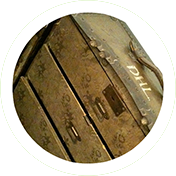
To celebrate Easter, David Brock takes a look at Lawrence’s controversial take on the Crucifixion in the essay ‘Resurrection’ and how Easter eggs led to the novel The Man Who Died.
In our so-called ‘Christian country’, we’re told fewer couples choose to marry in church. But let’s welcome this greater honesty. And while Easter is a commercial bonanza now. . .the stores stacked with machine-laid eggs – Easter is symbolic of Oestrus, and the Pagan origin of our great spring festival.
Unsurprisingly, D.H. Lawrence – who was brought up steeped in the Bible and Christian mythology, and has been depicted as a Christ-like figure himself, even described by some as ‘messianic’ – offers some challenging, alternative suggestions when it comes to the Church, the Easter Story and the Resurrection. What he says can help us all to rise up again, achieving fuller being, at this most regenerative time of year.
Inspired by the sight of eggs at Easter, and at first called The Escaped Cock, the subsequent title of Lawrence’s controversial fictional version of Christ coming back to life, and emerging from the tomb, The Man Who Died, tells us quite a lot. This is a mortal ‘Man’, rather than a Saviour, King of Kings or Son of God. This ‘Man’ has died the death of his old self, and his new, individual, flesh and blood self, has returned to life. He is taking the first hesitant steps away from a past he now repudiates, towards his difficult but vital human resurrection. He is becoming ‘The Man Who Lived’, rather than ‘The Christ Who Died’.
In a short essay, ‘Resurrection’, Lawrence berates fellow writer, Tolstoy, for wanting Christ to go on ‘being crucified everlastingly’, and urges all of that ilk to ‘Put away the Cross; it is obsolete.’ For the ‘stigmata’ are ‘healed up’. And ‘The Lord is risen,’
The Cross has become the ‘Tree of Life’ again, Lawrence insists. It has taken root and is issuing buds. However, the multitudes are mistakenly putting their Lord on the Cross again.
Whereas those who are prepared to rise along with the Risen Lord can do so as lords themselves. Facing inwards towards the ‘Whole God’ – which is, our central living integrity, the hub of our being – on the ‘Wheel of fire’, we can all be lit up with ‘bright and brighter and brightest and most-bright faces’, Lawrence believes.
In his poem, ‘The Risen Lord’ Lawrence’s Jesus opens his eyes ‘afresh’, seeing for the first time ‘people of flesh’. Having conquered the fear of death, he must now ‘conquer the fear of life’ – living as a ‘man among men’. He rejects the old denial of substance and physical desires – ‘never can denial deny them again.’
This vision in Lawrence of us all as Lords of Life is infectious. The last of his Pansies, ‘Prayer’, written as his health declined, expresses an extraordinary wish. . .one we might share – ‘Give me the moon at my feet / Put my feet upon the crescent, like a Lord!”
David organises a D.H. Lawrence reading, study and performance group, The Lawrence Players, which meets fortnightly, between 5 and 7 pm in Chapel-en-le-Frith library (18th April, 2nd, 16th, 30th May and so on). The ultimate aim of the group is to raise the profile of this radical exciting author by performing his work on stage.
Any enquiries, please contact David at vegan.lawrentian@gmail.com

In the DH Lawrence Memory Theatre we want to address various aspects of Lawrence’s life through artefacts to try to understand this complex writer. How do we get across Lawrence’s indifferent relationship with religion or the self-deification of his later works? Will chocolate eggs melt inside our memory theatre or hatch and rise from the flames? In 2019 we begin building our Memory Theatre and retracing Lawrence’s savage pilgrimage both physically and digitally. If you have an idea for an artefact get involved and submit ideas here
